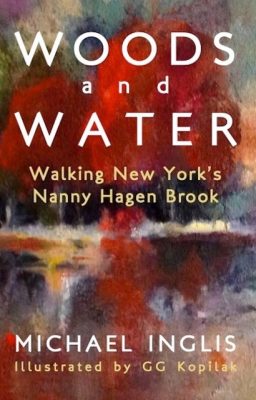Words and Images Meld in New Book By P’ville Environmentalist

In an exquisite rendering of a heron, its slender beak points to words that flow down the page that defies the standard block paragraph form. Rather, it follows the swell of the bird’s neck, then curves down to her delicate feet hidden in a tuft of grass.
This harmonious integration of image and words transports readers to Nanny Hagen Brook in Pleasantville, the place that inspired scientist and environmentalist Michael Inglis to pen his latest book “Woods and Water: Walking New York’s Nanny Hagen Brook.”
This is the first book written by Inglis, a 25-year Pleasantville resident. He has hiked along the brook and the connecting tributary streams that flow near his home garden. The changing flora and fauna from season to season fascinated him, deepening his connection to nature that is specific to Nanny Hagen Brook and the surrounding 40 acres that is “an edge ecosystem, tucked in between houses and developments.”
“North of my house is the aqueduct that crosses Broadway and is where I walked to the Nanna Hagen Pond and then beyond to the wild area, which I became very familiar with,” Inglis said.
His acute observations easily place images and sounds that allow the reader to see exactly how the wind ruffles leaves on the trees and the subtle greying of winter grass or a hawthorn thicket that reveals the passing of white-tailed deer.
Inglis’ writing voice is as if he is speaking only to the reader. His is a poetic and lyrical style that certainly spoke to artist GG Kopilak who created 45 illustrations and two maps for ‘Woods and Water.’
Kopilak’s paintings are shown in museums throughout the U.S. She is on the board of the Katonah Museum of Art and has taught high school art. For about seven years she and Inglis have produced short videos for PCTV entitled “Outside in Your Garden.”
It was Kopilak’s suggestion that the words in Inglis’ book blend with the pictures, an idea Inglis embraced.
“Michael sent me three chapters in the beginning and it was so beautifully poetic, Kopalik recalled. “He gave me carte blanche to how I created the images. I saw that the book wasn’t going to support illustrations being on a different page than the writing but that the illustrations would work better being within the writing.”
She worked with the graphics program photoshop using a digital pencil on her iPad. When Inglis sent her a photograph of a beaver slipping into the pond, he wrote how the animal created “a wake behind that paddling tail” and Kopilak knew it was one of the images she wanted to create.
“Michael’s picture didn’t include the tail or the water so the image is really a collage with an added tail, a water splash and the beaver’s head.”
Many environmental changes in flora and fauna over the last 25 years haven’t gone unnoticed.
“I’ve seen that the wonderful ash trees are gone and the beech tree has greatly declined,” Inglis said. “Invasive species such as mugwort has made its way to the edges of the roadside along with other invasives that have come to Westchester in a big way.”
But not all the changes are negative and Inglis said he welcomes the growing population of coyotes, beavers, bobcats and black bears.
“It’s kind of cool that we have these big mammals coming in,” he said.
For Inglis, the routine of close observation was a way to bring him into the present.
“Once in the present I could experience the eternal now as opposed to being lost wondering what happened last week or what you’re going to do next month, which is what most of us spend time thinking about. Bringing me into the present was the most important fundamental way I grew throughout the project.”
With the use of his iPhone, Inglis recorded his voice narrating what he was seeing, smelling or hearing as well as taking pictures. He suggested this as one way to encourage youngsters to become interested in nature.
“It may be a nice way for kids to be more active than passive and perhaps make their own videos using their phones,” Inglis said. “For me, using the technology on my phone was a key part to helping me write this book.”
At the beginning of each of the nine chapters is a quote by known naturalist writers that have inspired Inglis including John Muir, Aldo Leopold, Walt Whitman and Rachel Carson.
“This is a niche book about a niche area,” Inglis said. “To me, the connection we have with the land is really our place in the universe. It’s our way of being.”
The book is for sale at The Village Bookstore in Pleasantville and online.
Editor’s note: This article has been updated to state that this is the first book written by the author Michael Inglis. In the print version of this article, it was incorrectly reported that he had written previous books.

Abby is a local journalist who has reported on breaking news for more than 20 years. She currently covers community issues in The Examiner as a full-time reporter and has written for the paper since its inception in 2007. Read more from Abby’s editor-author bio here. Read Abbys’s archived work here: https://www.theexaminernews.com/author/ab-lub2019/


